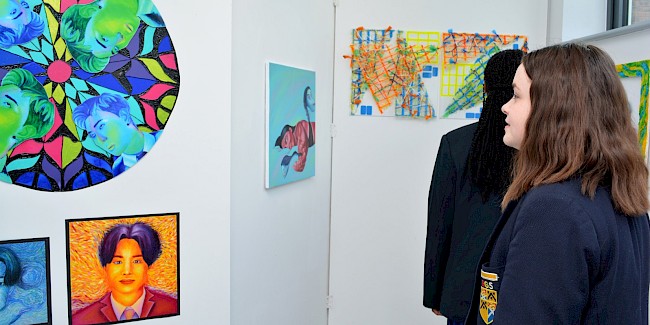Key Stage 5 Visual Art
Curriculum Overview:
Students at Key Stage 5 receive six lessons a fortnight and follow the IB Visual Art course as part of the IB Diploma. This course encourages students to challenge their own creative and cultural expectations and boundaries. It is a thought-provoking course in which students develop analytical skills in problem-solving and divergent thinking, while working towards technical proficiency and confidence as art-makers. In addition to exploring and comparing visual arts from different perspectives and in different contexts, students are expected to engage in, experiment with and critically reflect upon a wide range of contemporary practices and media. The course is designed for students who want to go on to further study of visual arts in higher education as well as for those who are seeking lifelong enrichment through visual arts.
Each Visual Arts course, Standard or Higher Level, consists of the following linked compulsory parts:
Theoretical practice: Students analyse and compare different artworks by different artists. This independent critical and contextual investigation explores artworks, objects and artefacts from differing cultural contexts.
Art-making process: Students submit carefully selected materials which evidence their experimentation, manipulation and refinement of a variety of visual arts activities during the 2-year course.
Curatorial practice: Students submit for assessment a selection of resolved artworks for exhibition. The selected pieces show evidence of their technical accomplishment during the Visual Arts Course and an understanding of the use of materials, ideas and practices appropriate in visual communication. To support their exhibition students, title their work and write a supporting curatorial rational as to why they have exhibited their work in the way and manner they have.
| | Term 1 | Term 2 | Term 3 | Term 4 | Term 5 | Term 6 |
|---|
| Year 12 | Drawing with Meaning and exploration of style
| Colour through painting and photography | Own work- new subtheme- personal research development and critical and contextual work
| Own Work
Idea development and further visuals, artists and media exploration to develop further outcomes | Own work
Final development and completion of further outcome and select pages to refine for Process portfolio | Own work exhibition outcomes and research/analysis for comparative study |
| Year 13 | Own work
Ideas, initial thinking, analysis, visual research and outcome Comparative Study | Own Work
Idea development and further visuals, artists and media exploration to develop further outcomes | Own work
Final development and completion of further outcome and select pages for Process portfolio | Refine all Exhibition outcomes, complete critical reflections and the Curatorial Rationale. Set up exhibition. | | |
Year 12
This component allows students opportunities to generate and develop ideas, research primary and contextual sources, record practical and written observations, experiment with media and processes and refine ideas towards producing resolved outcomes.
Within year 12 students start the year with workshops into new media such as oil painting and ink, as well as developing refinement of skill in charcoal, soft pastel and other media. Students are encouraged to work on a more independent level, developing individual outcomes by connecting to their own interests and beliefs.
Students are also given the opportunity to experience creating an outcome for an actual exhibition and to understand the context, curatorial rationale and place in society.
In addition, throughout both Year 12 and 13, we will go on Art trips to enable students to see a wide range of art. Students will also have an opportunity to work as a group to create a set design and to be involved in Arts projects in school such as the Art Commission.
Year 13
Students build upon their personal investigation work started in year 12, creating a further development and outcome, exploring their own personal theme and interest. To support their practical work students also create exhibition reviews, artist analyses and written critical reflections exploring key artists who have influenced their work.
Students continue to build upon the 3 areas of study into their 2nd year, theoretical practices, art-making practice, curatorial practice.
Assessment at IB
Final assessment for the IB is through the IA exhibition of work chosen from the 2 year IB course. Students electronically document all their work for moderation and marking which is sent to the external examiner EA in the form of the process portfolio and the comparative study. There is no external set examination; student will develop their own creative process, which will culminate in the final exhibition. This course is 100% coursework.
- a) Comparative study
This is 20% of the overall level which is externally assessed. It consists of:
10–15 screens which examine and compare at least 3 artworks, at least 2 of which need to be by different artists
• 3–5 screens which analyse the extent to which the student’s work and practices have been influenced by the art and artists examined
• A list of sources used - b) Process Portfolio
This is 40% of the overall level which is internally assessed. It consists of:
13–25 screens for HL which evidence sustained experimentation, exploration, manipulation and refinement of a variety of art-making activities - c) Exhibition
This is 40% of the overall level which is internally assessed. It consists of:
An Exhibition
• A curatorial rationale that does not exceed 700 words
• 8–11 developed artworks in own choice of media
• Exhibition text (stating the title, medium, size and intention) for each artwork
Further Reading/Resources
– Book: …isms by Stephen Little
– Book: The Story of Art by Ernst Gombrich
– Book: Art Today by Edward Lucie-Smith
– Book: What are you looking at? By Will Gompertz
– Book: Why Your Five Year Old Could Not Have Done that: Modern Art Explained by Susie Hodge
– Book: Visual Arts doe the IB Diploma Coursebook
– Websites: www.npg.org.uk, www.art.com, www.tate.org.com, www.artareas.com,, www.artcyclopedia.com, www.artlex.com
– Exhibitions: Tate Modern and Britain, National Gallery, National Portrait Gallery, Saatchi Gallery, The Hayward Gallery, The British Museum, The Victoria and Albert Museum, Local galleries Etc



